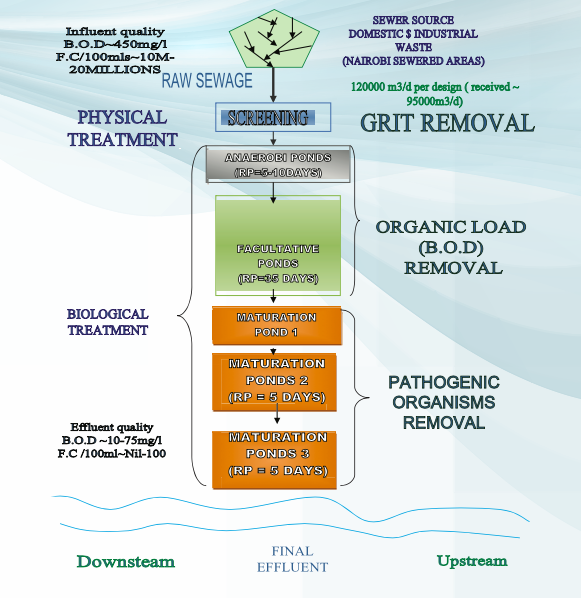The plant is located at 26 km from Nairobi city along Kangundo road, east of the city along eastern bypass at Ruai. The land on which it occupies is approximately 4,000 acres
The Dandora Estate Sewerage Treatment Works (DSTW) phase 1 construction started in 1975; the plant was commissioned in the year 1978. Phase II construction started in 1985 with a new inlet treatment work and additional 6 series which were commissioned in 1990. Between 2005 and 2014 anaerobic ponds were constructed and completed.
The plant treats domestic and industrial about 120,0000m3/day equivalent to about 80% of waste water generated from Nairobi city. The design capacity for the plant is 160,000 m3.
Treatment Process involves two processes;
- Physical Treatment
- Biological Treatement
- Physical treatment
The waste water at the inlet works is passed through screens which are ;
- Coarse screens
- Intermediate Screens
- Fine Screens
- Grit trap
- Compactor
2.Biological Treatment
- Anaerobic Ponds.
The ponds are 4meters deep and this allows anaerobic bacteria to eat up the organic waste thereby helping in lowering the organic load of the waste. 60% organic load reduction is done in the anaerobic ponds. Waste water is retained in these ponds for approximately 5 days
- Facultative pond
The facultative are 1.7 metres deep 700m by 300m surface area. The retention period is 35 days whereby both the anaerobic and aerobic bacteria eat up the organic waste helping further reduce the organic load of the waste water.
- Maturation pond.
After the facultative pond there are three maturation ponds in series. The maturation pond are 1.2 meters deep and 300m by 150m.The depth allows the sunrays to penetrate to aid in eliminating of the pathogenic organisms such as e-Coli.
Waste water quality is monitored daily for the inflow, outflow, upstream and downstream and along the series monthly.

